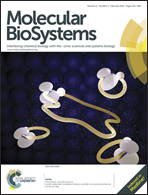The plasma metabolic profiling of chronic acephate exposure in rats via an ultra-performance liquid chromatography-mass spectrometry based metabonomic method
Abstract
This study aimed to investigate the toxic effects of long-term, low-dose acephate administration on rats using ultra-performance liquid chromatography-mass spectrometry. A total of 120 male Wistar rats were randomly assigned to different groups: control; low-dose acephate (0.5 mg kg−1 bw−1); middle-dose acephate (1.5 mg kg−1 bw−1); and high-dose acephate (4.5 mg kg−1 bw−1). The rats continuously received acephate via drinking water for 24 weeks. Rat plasma samples were collected at different time points to measure metabonomic profiles. Liver tissues were subjected to histopathological examination. The results showed that 10 metabolites in the plasma were significantly changed in the treated groups compared with those in the control group (P < 0.05 or P < 0.01). Exposure to acephate resulted in increased lysoPC (15 : 0), lysoPC (16 : 0), lysoPC (O-18 : 0), lysoPC (18 : 1(9Z)), lysoPC (18 : 0), lysoPC (20 : 4(5Z, 8Z, 11Z, 14Z)), arachidonic acid, and 12-HETE as well as decreased tryptophan and indoleacrylic acid in rat plasma. Moreover, the contents of high-density lipoprotein, low-density lipoprotein, triglyceride, total cholesterol, free fatty acids, and malondialdehyde, as well as the activities of superoxide dismutase and phospholipaseA2 in the serum, were significantly changed in the middle- and high-dose groups compared with those in the control group (P < 0.05 or P < 0.01). Histopathological examination results revealed that exposure to acephate may induce vacuolar degeneration in the liver cell cytoplasm, fat degeneration, and liver cell necrosis. These results indicated that exposure to acephate disrupted metabolism of lipids and amino acids, induced oxidative stress, caused neurotoxicity, and resulted in liver dysfunction.


 Please wait while we load your content...
Please wait while we load your content...